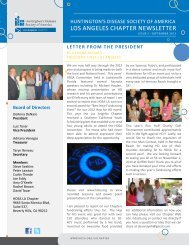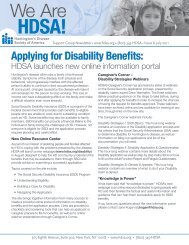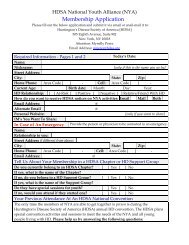Coping with Obsessive/Compulsive Behaviors in Huntington's ...
Coping with Obsessive/Compulsive Behaviors in Huntington's ...
Coping with Obsessive/Compulsive Behaviors in Huntington's ...
You also want an ePaper? Increase the reach of your titles
YUMPU automatically turns print PDFs into web optimized ePapers that Google loves.
<strong>Cop<strong>in</strong>g</strong> <strong>with</strong> <strong>Obsessive</strong>/<strong>Compulsive</strong> <strong>Behaviors</strong> <strong>in</strong><br />
Hunt<strong>in</strong>gton’s Disease<br />
Presentation by Danielle Bl<strong>in</strong>koff, B.A.<br />
University of South Florida, Cl<strong>in</strong>ical Psychology Doctoral Program<br />
HDSA Center of Excellence at University of South Florida
The <strong>in</strong>formation provided by speakers <strong>in</strong><br />
workshops, forums, shar<strong>in</strong>g/network<strong>in</strong>g sessions<br />
and any other educational presentation made as<br />
part of the 2013 HDSA Convention program is<br />
for <strong>in</strong>formational use only.<br />
HDSA encourages all attendees to consult<br />
<strong>with</strong> their primary care provider, neurologist or<br />
other healthcare provider about any advice,<br />
exercise, medication, treatment, nutritional<br />
supplement or regimen that may have been<br />
mentioned as part of any presentation.
Presenter Disclosures<br />
Danielle Bl<strong>in</strong>koff<br />
The follow<strong>in</strong>g personal f<strong>in</strong>ancial relationships <strong>with</strong><br />
commercial <strong>in</strong>terests relevant to this presentation<br />
existed dur<strong>in</strong>g the past 12 months:<br />
No relationships to disclose<br />
or list
Danielle Bl<strong>in</strong>koff<br />
• Cl<strong>in</strong>ical Psychology Ph.D. Student at the University<br />
of South Florida<br />
• Study<strong>in</strong>g Neuropsychology.<br />
• Research <strong>in</strong>terests are <strong>in</strong> dementia, executive<br />
functions<br />
• Currently cl<strong>in</strong>ical research coord<strong>in</strong>ator at the HDSA<br />
Center of Excellence at the University of South<br />
Florida.
Presentation Outl<strong>in</strong>e<br />
• What are perseverations?<br />
• What are obsessions and compulsions?<br />
– Why do they occur?<br />
– How are they different from perseverations?<br />
– Why are they unique <strong>in</strong> HD?<br />
– Strategies for cop<strong>in</strong>g
Prevalence of <strong>Obsessive</strong> and <strong>Compulsive</strong> <strong>Behaviors</strong> <strong>in</strong> HD<br />
• 20-50% of patients <strong>with</strong> HD report obsessions<br />
and/or compulsive behaviors (Anderson et al., 2010;Anderson et<br />
al., 2001; Begl<strong>in</strong>ger et al., 2007; Marder et al., 2000, Paulsen et al., 2001).<br />
– Most <strong>in</strong>dividuals have features of OCD, but don’t<br />
meet criteria (Naard<strong>in</strong>g et al., 2003; Anderson et al., 2001).<br />
• Compared to 5.5% of obsessions and/or<br />
compulsions <strong>in</strong> the general population (Anderson et al., 2010;<br />
Degonda et al., 1993).
Comorbidities: <strong>Obsessive</strong> and <strong>Compulsive</strong> <strong>Behaviors</strong> <strong>in</strong> HD<br />
• Psychiatric:<br />
– Associated <strong>with</strong> higher rates of depression, suicidal<br />
ideation, aggression, delusions and halluc<strong>in</strong>ations.<br />
• Cognitive:<br />
– Associated <strong>with</strong> poorer executive function (Inhibition).<br />
• Demographics:<br />
– Associated <strong>with</strong> older age, poorer function<strong>in</strong>g, longer<br />
duration of illness.<br />
(Anderson et al., 2010)
Scenario<br />
• A 60 year old woman <strong>with</strong> HD has an appo<strong>in</strong>tment to<br />
see her neurologist later <strong>in</strong> the day.<br />
• She always has concerns about medications. She<br />
never likes tak<strong>in</strong>g medications because she worries<br />
about side effects. She especially gets upset if there<br />
are any changes to medications.
Scenario<br />
• The whole morn<strong>in</strong>g of the appo<strong>in</strong>tment she constantly<br />
says th<strong>in</strong>gs to her caregiver about medications like: “the<br />
doctor better not change my medications. I’m not tak<strong>in</strong>g<br />
more medications.”<br />
• This extends <strong>in</strong>to the whole ride to the doctors office and<br />
while sitt<strong>in</strong>g <strong>in</strong> the wait<strong>in</strong>g room.<br />
• The doctor makes changes to her meds, and this upsets<br />
her. She cannot stop ask<strong>in</strong>g about why these medications<br />
need to be changed and cannot change topics.<br />
• She rema<strong>in</strong>s upset and frustrated about this the whole<br />
way home.
What’s Happen<strong>in</strong>g <strong>in</strong> This Situation?
Perseverations : Gett<strong>in</strong>g Stuck<br />
• http://ians1stblog.files.wordpress.com/2010/12/santa-stuck.jpg
Perseverations: Gett<strong>in</strong>g Stuck<br />
• Rigidity <strong>in</strong> behavior<br />
• Unable to change rout<strong>in</strong>es<br />
• Gett<strong>in</strong>g stuck on the same idea or action<br />
• Unable to go from one activity to another (Paulsen,<br />
1999).
Perseverations: Gett<strong>in</strong>g Stuck<br />
• Perseverations are usually more evident to others than<br />
the patient.<br />
– Not an <strong>in</strong>trusive thought.<br />
• Person does not recognize that the thoughts are a<br />
product of his or her own m<strong>in</strong>d.<br />
– Th<strong>in</strong>k these are true concerns.<br />
– Typically don’t realize they are stuck.
Perseveration: Topics<br />
• Many times revolve around loss of certa<strong>in</strong> privileges.<br />
– Driv<strong>in</strong>g<br />
– Us<strong>in</strong>g the stove<br />
– Go<strong>in</strong>g to the store alone<br />
– Manag<strong>in</strong>g f<strong>in</strong>ances<br />
• Can be other random topics as well.<br />
– Trouble <strong>with</strong> a neighbor (Paulsen, 2011).
What is an Obsession?<br />
• Person recognizes that the thoughts are from his or her<br />
own m<strong>in</strong>d.<br />
– This is what makes it different from a perseveration.<br />
• Thoughts are persistent and causes anxiety and<br />
distress.<br />
• Person tries to stop the thoughts <strong>in</strong> some way.<br />
– DSM-IV-TR 2000
What is a Compulsion?<br />
• An action that attempts alleviate anxiety caused from an obsession<br />
– Hand Wash<strong>in</strong>g<br />
– Count<strong>in</strong>g<br />
– Organiz<strong>in</strong>g/Arrang<strong>in</strong>g<br />
– Repeat<strong>in</strong>g words or statements<br />
– Hoard<strong>in</strong>g items<br />
– Repeated trips to the rest room<br />
• Compulsions are excessive acts and don’t necessarily neutralize the<br />
supposed threat.<br />
• Compulsions can be time consum<strong>in</strong>g and <strong>in</strong>terfere <strong>with</strong> the person’s normal<br />
rout<strong>in</strong>e.<br />
– DSM-IV-TR, 2000
Why do Perseverations, Obsessions and Compulsions<br />
Occur?<br />
• Frontal Lobes<br />
– Circuitry go<strong>in</strong>g from basal ganglia to frontal lobes is<br />
disrupted.<br />
• Executive Dysfunction<br />
– Set-shift<strong>in</strong>g Difficulties<br />
• Person’s needs are not be<strong>in</strong>g met.
Frontal Lobes & The Basal Ganglia<br />
• Disruption of frontal striatal circuitry.<br />
• <strong>Obsessive</strong> and compulsive behaviors are l<strong>in</strong>ked to the caudate, globus<br />
pallidus, and frontal lobe dysfunction.<br />
• Problem <strong>with</strong> the basal ganglia leads to problems <strong>in</strong> other parts of the<br />
bra<strong>in</strong>.
Frontal Lobes and Behavioral Regulation: The Decision<br />
Maker<br />
http://simonma<strong>in</strong>war<strong>in</strong>g.com/wp-content/uploads/2011/06/ceo.jpg
When the rest of the workers are do<strong>in</strong>g their job, the CEO<br />
can make good decisions & the company runs smoothly<br />
http://www.nekls.org/wp-content/uploads/board-clip-art.gif
The CEO can’t make good decisions if his or her workers<br />
are do<strong>in</strong>g their job properly.
In HD, sleepy workers <strong>in</strong> the basal ganglia disrupt the work<br />
of the CEO <strong>in</strong> the frontal lobes.
Set-Shift<strong>in</strong>g Example<br />
• F<strong>in</strong>d All of the Green Circles! How many are there?
Set-Shift<strong>in</strong>g Example<br />
• F<strong>in</strong>d All of the Green Squares! How many are there?
Set-Shift<strong>in</strong>g<br />
• In example 1, the correct answer is 5 (green circles).<br />
Both people <strong>with</strong> and <strong>with</strong>out set-shift<strong>in</strong>g problems<br />
should get this correct.<br />
• In example 2, the correct answer is 4 (green squares).<br />
– Set-shift<strong>in</strong>g difficulties: 6 (green circles).<br />
• Why does this occur?<br />
– Difficulties shift<strong>in</strong>g to the new rule!<br />
– Got stuck to the old rule!
Keep <strong>in</strong> M<strong>in</strong>d…Needs<br />
• Sometimes, the person may actually need someth<strong>in</strong>g<br />
and is hav<strong>in</strong>g trouble express<strong>in</strong>g that need.<br />
http://thumbs.dreamstime.com/thumblarge_262/1209207763H2Yw6c.jpg
Obsessions and Compulsions <strong>in</strong> HD are Unique<br />
• Traditional ways of deal<strong>in</strong>g <strong>with</strong> patients <strong>with</strong><br />
obsessive-compulsive disorder may not work for<br />
this population.
Manage Expectations<br />
http://1.bp.blogspot.com/_k4ZjEbQtTyo/TQJ4VylECAI/AAAAAAAAB8k/4Ri1yCIsCpQ/s1600/unrealistic+expectation<br />
s.jpg
Pick Your Battles<br />
http://icons.iconarchive.com/icons/icons-land/sport/256/Box<strong>in</strong>g-Gloves-icon.png
However…<br />
• When safety is an issue it is more important to <strong>in</strong>tervene than<br />
to ignore<br />
• Sometimes there is no reason<strong>in</strong>g <strong>with</strong> the person<br />
– Reason<strong>in</strong>g ability is impaired.
<strong>Cop<strong>in</strong>g</strong> <strong>with</strong> <strong>Behaviors</strong><br />
• Remember set-shift<strong>in</strong>g is difficult, so you need to help!<br />
• It’s your job to break the cognitive set!
Break the Cognitive Set!<br />
• With Distraction!<br />
– Make a list of activities or food that the person likes.<br />
– Humor.<br />
• Us<strong>in</strong>g that could stop the repetitive behavior.
Sett<strong>in</strong>g a rout<strong>in</strong>e<br />
• General technique that is used to manage many behaviors <strong>in</strong> HD.<br />
• It’s often distress<strong>in</strong>g to change rules or rout<strong>in</strong>es, so try to stick to a<br />
schedule.<br />
http://cpsobsessed.files.wordpress.com/2013/01/calendar.gif
Don’t Make False Promises<br />
• For caregivers, don’t promise you will do someth<strong>in</strong>g if you are not go<strong>in</strong>g to<br />
follow through:<br />
– If you say “I’ll do it <strong>in</strong> a m<strong>in</strong>ute” be sure to uphold that, otherwise don’t<br />
say it.<br />
http://cdn.bus<strong>in</strong>ess2community.com/wp-content/uploads/2012/09/false-promises.jpg
Set a Time Limit<br />
• For caregivers, set a time limit on how long you will discuss the<br />
perseveration.<br />
– Sometimes you won’t be able to solve it.<br />
• Expla<strong>in</strong> that the topic has been discussed.<br />
– Work<strong>in</strong>g on fix<strong>in</strong>g the problem.<br />
http://hcgreenthumb.files.wordpress.com/2011/03/daylight-sav<strong>in</strong>gs-time.jpg
Experience<br />
• If perseverations persist, arrange an experience that may put an end to the<br />
topic.<br />
• Want<strong>in</strong>g to drive<br />
– Arrange for a driv<strong>in</strong>g evaluation.<br />
– The driv<strong>in</strong>g evaluator becomes the “bad guy.”<br />
http://www.cks<strong>in</strong>fo.com/clipart/signssymbols/bwsigns/car-rental.png
Avoid the Negative and Embrace the Positive<br />
• Turn a “No” <strong>in</strong>to a “Yes.”<br />
• Instead of “No, it’s not time yet” say, “Yes, you can at 11am.”<br />
• Sometimes it’s just about how your frame a response.<br />
http://www.healthylifestylesliv<strong>in</strong>g.com/wp-content/uploads/2012/05/lemons-<strong>in</strong>to-lemonade.jpg
Deal<strong>in</strong>g <strong>with</strong> Compulsions<br />
• Is the compulsion caus<strong>in</strong>g practical problems?<br />
• Can it be ignored?<br />
– Sometimes behavior gives the person a sense of<br />
purpose.<br />
– If it isn’t caus<strong>in</strong>g practical problems, consider ignor<strong>in</strong>g<br />
it.
Deal<strong>in</strong>g <strong>with</strong> Compulsions<br />
• If ignor<strong>in</strong>g it is not an option:<br />
– Try Distraction<br />
– Can the behavior be turned <strong>in</strong>to someth<strong>in</strong>g<br />
productive?<br />
• Fold<strong>in</strong>g Laundry
Summary<br />
• Perseverations, Obsessions and <strong>Compulsive</strong> behavior occur <strong>in</strong> 20-50% of<br />
patients <strong>with</strong> HD.<br />
• These behaviors are due to disruptions <strong>in</strong> bra<strong>in</strong> circuitry.<br />
– The CEO cannot manage properly.<br />
• <strong>Cop<strong>in</strong>g</strong> <strong>with</strong> these behaviors:<br />
– Manage your expectations<br />
– Pick your battles<br />
– Break the cognitive set <strong>with</strong> distractions or humor<br />
– Set a rout<strong>in</strong>e<br />
– Don’t make false promises<br />
– Set a time limit<br />
– Arrange an experience to solve the problem<br />
– Avoid negatives<br />
– Turn<strong>in</strong>g compulsion <strong>in</strong>to someth<strong>in</strong>g productiv
Resources<br />
• Driv<strong>in</strong>g Information:<br />
– http://www.helpguide.org/elder/senior_citizen_driv<strong>in</strong>g.htm<br />
• General Information about HD:<br />
– http://stanford.edu/group/hopes/cgi-b<strong>in</strong>/wordpress/<br />
– http://hdscotland.org/images/stories/InformationResources/physicians_g<br />
uide.pdf<br />
– http://www.hdsa.org/liv<strong>in</strong>g-<strong>with</strong>-hunt<strong>in</strong>gtons/publications/<strong>in</strong>dex.html<br />
• Nance, Paulsen, Rosenblatt, & Wheelock (2011). A Physician’s Guide to the<br />
Management of Hunt<strong>in</strong>gton’s Disease. HDSA. USA.<br />
• Paulsen (1999). Understand<strong>in</strong>g Behavior <strong>in</strong> Hunt<strong>in</strong>gton’s Disease. HDSA.<br />
• Pollard, Best, Imbigilo, Klasner, Rub<strong>in</strong>, Sanders, & Simpson (1999). A<br />
Caregiver’s Handbook for Advanced-Stage Hunt<strong>in</strong>gton’s Disease. HDSA.
Questions?<br />
http://engauge.engauge.co.uk/wp-content/uploads/2009/02/questions20.jpg

















